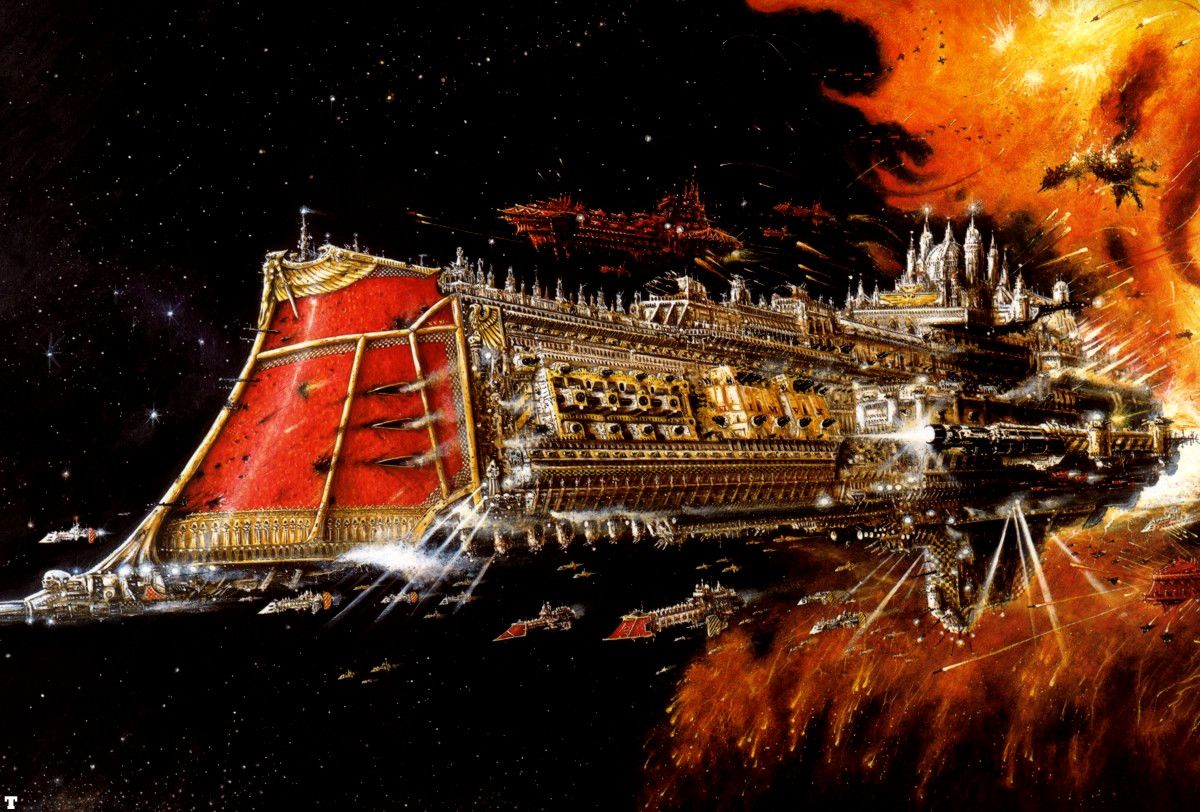To close out our series on the fantastic world of Battlefleet Gothic, we’re going to take a look at just a few of the more prominent expanded play fleets and rules and dig into a bit of the narrative universe around both Battlefleet Gothic and Warhammer 40,000 that the games can open up. I do want to note that as BFG moved into the later stages of its official life, the rules for some of the expanded fleets not listed here did get increasingly unbalanced – for this reason I will not cover them here. However, I also note that the player community itself has stepped in as it had with Blood Bowl and worked to balance much of the later rules. I encourage you to seek out the “Battlefleet Gothic” Facebook group for a vibrant and active group! If you missed them, click here to read parts one, two, and three.
Before we go on, my extremely derogatory review of the Tau Merchant Fleets got quite the response. I, of course, believe it’s entirely fair but a challenger has arisen to provide a counterpoint! Max Kircher has pulled out his writing quill, splashed some ink onto the page, and given a much more level-headed review of the Tau Merchant fleets below – enjoy!
The Tau Exploration Fleets – Take 2
People often like to talk down about the Tau Exploration fleet in BFG, calling it lame or some variation thereof. Nothing could be further from the truth! After seeing the rough treatment they got in the last article, this veteran Kor’O decided to send over an overview of my favorite BFG fleet that did them justice!
Why You Should Play Tau
Let’s be honest here – relentless Grim Darkness all the time gets exhausting after a while.
The Tau harken back to the good old days of classic space opera, where exploring the cosmos is the aim of the game and there is no problem your plucky heroes can’t solve with enough science and reason. Since they spend as much time on non-violent missions as violent ones, the Tau Exploration Fleet has rich opportunities for scenarios and fluff and offers a refreshing change of pace from ‘Brutally Dominate Everything’ and ‘Brutally Destroy Everything’.
If you like getting a warm fuzzy feeling from knowing you made the universe a better place each time you win a game, the Tau are the fleet for you.
What’s Different About Tau Fleets?
How Do They Play?
If you are familiar at all with the Tau in 40k, you’ll know that when it comes to combat doctrine, they march to their own drumbeat. Where the other forces of the 41st Millennium fight like Bronze Age, Napoleonic or sometimes WWII armies dressed up with laser cannons and chainswords, the Tau practice a style of fighting firmly rooted in modern warfare.
The Tau Exploration Fleet is exactly the same in BFG. Where other fleets play like Age of Sail or Jutland era navies and pirates (or horrifying space monsters), the Tau play just like a Cold War or modern-day navy. Their shooting is a backup, there to finish off stragglers, while the REAL damage comes from their ordnance. The Exploration fleet in particular plays like a US Navy Carrier Group – most of the combat ships are there to guard the carriers while their attack craft bomb the enemy back to the Stone Age.
Special Rules
The last article covered most of the important special rules for the Tau, but there are a couple of key points it missed out:
- One of the big icons of the Tau, the Manta is the main bomber for the Tau fleet. Like Thunderhawks and Eldar, they get a 4+ to stay on-table the first time they get intercepted.
- Fire Arcs. Not a special rule as such, but an important thing to talk about with Tau ships. While most BFG ships use a few medium-big guns in fixed fire-arcs, Tau ships use lots of small guns with overlapping fire-arcs. The big point is that every single one of them shoot forwards, so you need to add them together to work out a Tau ship’s maximum firepower.
The Tau Order of Battle
Gal’leath (Explorer) Class Starship
The Explorer will be the heart of most Exploration fleets, especially in larger games where you have to take one. It might not look like much on first glance, with only 1 shield, 15cm speed and just a strength 6 gun battery in the front, but you don’t take them for those things – you take them for ordnance. 8 Launch Bays for 230 points is a STEAL, especially when there’s no limit to how many of them you can take. They can dish out some serious pain, just keep them guarded while they’re raining death from afar.
Il’fannor (Merchant) Class Starship
As well as being a cool looking model, this ship has some of the coolest fluff in BFG, being basically the Rebel Blockade Runner or Firefly Class of the 40k universe. In the game they’re a cheap little gunboat that’s great for covering the broadside flanks of your other ships – Tau ships really don’t like enemies getting next to them, so having some reasonable shooting to finish off anything that makes it past the ordnance is always handy.
Lar’Shi (Hero) Class Starship
This is the Tau’s answer to battlecruisers and heavy cruisers. It’s a bruiser of a ship, with 6+ front armour (thanks deflector!), 2 launch bays, 6 missile tubes and your choice of either 4 lances and a strength 4 gun battery or a strength 12 gun battery to the front. These puppies are there to form the first line of defence for the Explorer carriers, and their two launch bays can give out fighter cover (letting the carriers focus more on Mantas) while they pelt the enemy fleet with missiles on approach. Its only weakness is that you require an attendant Explorer or Merchant for each Hero you take.
Kir’qath (Defender) Class Starship
I love these guys. They play very differently to other escorts of any kind – think of them less as an escort and more as a missile launcher with engines. Their job is to sit on the flanks of your formation and flood the board with missile salvoes, before peppering any survivors with a decent amount of gun battery power. Used in this way they’ve served me well in all my games so far.
Skether’qan (Messenger) Class Starship
Remember earlier when I said the Tau Exploration fleet plays like a USN Carrier Group? Well here’s your AEGIS system. It only has 1 point of shooting power, but you don’t take the Skether’qan to fight. You take it for the on-board Tracking System, which lets any friendly ship within 15cm ignore range penalties when shooting and re-roll turret dice to shoot down incoming ordnance. A must-have in larger games, especially against Eldar!
Kass’l (Orca) Gunship
Not to be confused with the Orca dropship in 40k and Aeronautica, the Orca gunship has all the same stats as the Imperial Firestorm, so most of what was written about that applies here. The important difference is that the Orca only costs 25 points, making it a great cheap way of tying up fast-moving flankers and other unexpected threats while you bring your main strike groups to bear.
Thanks a lot Max! Both for reading and responding with your well thought out counter – I may just have to reconsider my stance on Tau! Next up, I’m going to look at a couple of other fleets that have some prominence, Craftworld Eldar and Adeptus Mechanicus fleets!
Craftworld Eldar (Asuryani)
The Craftworlds introduction in BFG are an acknowledgement that the Corsair fleets of the Eldar are a pirate or exploration fleet not fully aligned to the interests of the Asuryani (the post Chapter Approved legal battle convention for Craftworld Eldar) or any one Craftworld. While the Corsair fleets are more akin to Rogue Traders, the Craftworld fleets represent the fighting ships of the Craftworld itself.
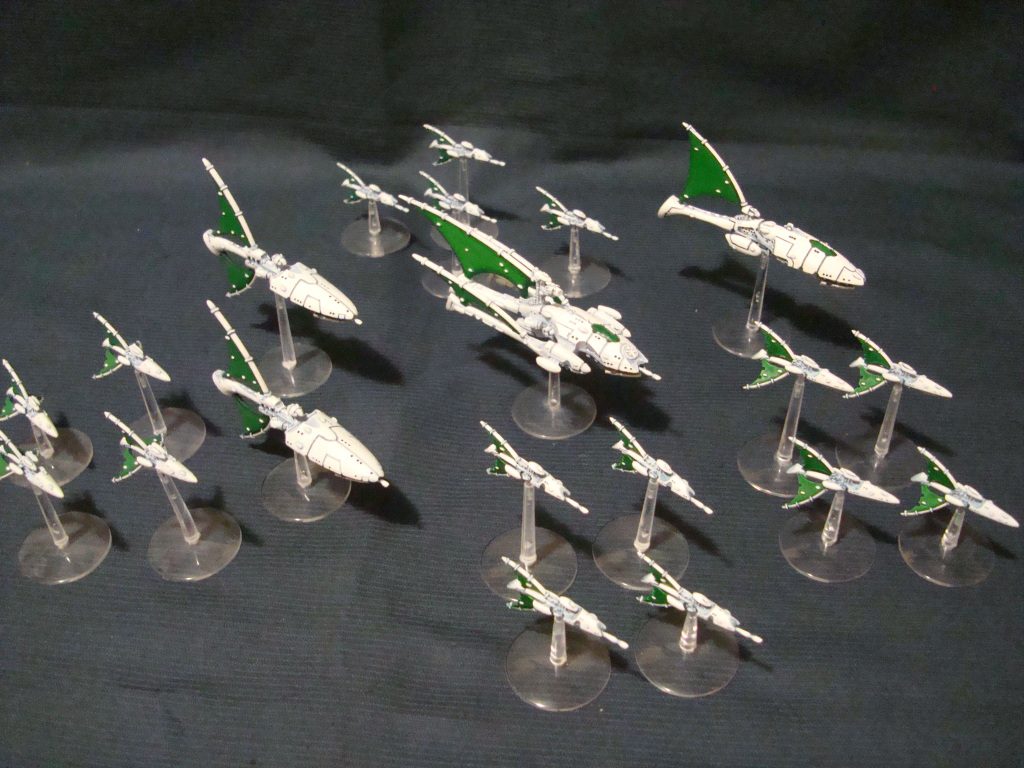
Why You Should Play Craftworlds
Honestly? Because you like Eldar and want to bring some Craftworld themed units. They are not nearly as variable as the Corsairs but they can make a fun change of pace or addition to your standard fleet and provide a little more resilience – and in that role they are perfect.
What’s Different About the Craftworlds
How Do They Play?
For all intents and purposes, the Craftworlds play very similar to the Corsair fleets -they are a little slower but come with better armor similar to the Dark Eldar (Drukhari). They further augment the resilience by bringing the option to add in Ghostships, which are the Wraith-units of the fleet that can provide further toughness, but trade off some of the flexibility.
Special Rules
The Craftworlds bring along most of the special rules for movement, holofields, weaponry, and critical damage that the Corsairs have already introduced with one minor exception to lances and then a number of additional features.
- Phantom Lances: A lance variety that forgoes the typical Pulsar profile that allows rolling additional hits.
- Farseers: Provide a reroll to the ship they are on or any nearby ships
- Aspect Warriors: An upgrade to a ship’s crew that adds +2 to boarding actions or +1 to hit-and-run attacks
- Ghostships: The wraith-driven vessels of the Craftworld. Any or all vessels may be a ghostship which then receive a variety of trade-offs, but primarily they add a bit more resilience to the fleet by trading off flexibility. Ghostships grant normal Eldar leadership but when taking command checks they run the risk of not being able to do anything the rest of the turn (or next turn if Bracing) when failing the checks. Fortunately, this will not affect the rest of your fleet living like a normal failed check. Additionally, since the crews are mostly or entirely Wraith’s, they are far more resilient to critical hits than the typical Eldar ship, and are only critical’d on a 6 rather than a 4+. Unfortunately, this also comes with a significant decrease in the capability for damage control and they cannot carry launch bays, conduct boarding actions or hit-and-runs, and give enemies bonuses to these actions.
The Craftworld Order of Battle
Like their Dark Eldar cousins, the Craftworld fleets are comprised of a couple of vessels that have some limited flexibility in weapon options for both prow and keel armaments.
Dragonship Cruisers
The heavy hitters of the Craftworld fleets, the Dragonships may choose from a staggering 16 strength Eldar battery or 3 Pulsars on the prow and then a salvo size 6 torpedo spread or 4 launch bays on the keel. This makes them highly flexible in their approach to fleet building as you can take everything you want at a standard cost of 260 points. This may be a little expensive if you build a Shadow equivalent, but the Eclipse equivalent (or the mix between the two) is generally a good value given the increased armor profile and slightly larger weapon capacity.
Wraithship Cruisers
The Wraithship (not to be confused with ghostships, or wraith-piloted ships) are the smaller version of the Dragonship and come with reduced weapon capacities but with a decreased cost of 160 points. The value here is in the lance and torpedo versions, as the reduction is slightly less than half vs the Dragonships while both weapon battery and hanger space is halved.
Shadowhunter Escorts
Like the cheaper Corsair escorts but less effective at the same cost. Armed with either a 3-strength weapon battery or a single phantom lance (the bad version of Eldar lances) they don’t put nearly as much hurt as Corsair equivalents. However, they are effective at hunting enemy ordnance as they do pick up a unique ability to destroy enemy ordnance markers on a 4+ rather than a 6. For this reason, you won’t want as many in the fleet as you might with the Corsairs, but they do have a very clear role in keeping enemy bomber/torpedo waves at bay (the fewer rolls on Holofields the better!).
Adeptus Mechanicus
The Adeptus Mechanicus fleets extend the search of knowledge and long-forgotten technologies to the stars for those who hail the Machine God of Mars. Ever in search of knowledge and the rumor or hint of a working STC, the Ad Mech ships are the pinnacle of current human technology within the Imperium – and they definitely keep the best for themselves.
Why You Should Play Adeptus Mechanicus
Because you like Imperial fleets but also like your ships to be just a little bit more powerful. The Ad Mech after all are more technologically advanced than their Imperial Navy counterparts… by design. Also, you like cyborgs and robits. Also, also, Nova Cannons.
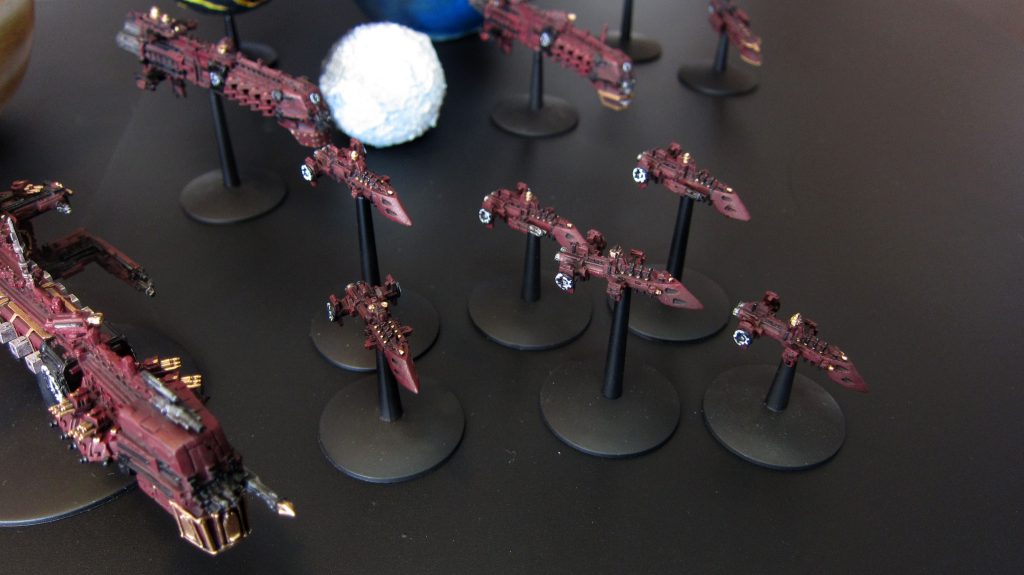
What’s Different About the Adeptus Mechanicus
How Do They Play?
On their face, Ad Mech plays remarkably similar to the Imperial Navy. However, there are several rules, refits, and weapon options that can drastically change how the fleet plays compared to the traditional Imperial fleet. For one, Nova Cannons can be equipped on nearly every vessel in the fleet which dramatically impacts the tabletop play for both players. In this regard, Ad Mech are much more a fleet of stand-off punishment than their Imperial Navy cousins, who will want to close to take advantage of their powerful but shorter-ranged weapons.
Special Rules
- All Ad Mech vessels are automatically refitted with one of six options that improves their capabilities in various ways. These options are rolled for randomly after determining leadership.
- Ad Mech vessels roll for leadership on a custom table from 7 – 9, additionally, any roll of a 6 for a ship allows them to choose a custom refit rather than rolling randomly. A vessel captained by an Archmagos Veneratus does not benefit from this.
- While Ad Mech ships do contain Skitarii, they are not in large enough numbers to prevent effective defense to boarding operations. As a result, enemy ships may reroll the dice when boarding or conducting a hit-and-run attack against Ad Mech vessels.
- Ad Mech ships contain such valuable technology that the Ad Mech would prefer their vessels destroyed than see them captured by the enemy. As a result, the Ad Mech have a capability to fire on their own drifting hulked vessels – denying their opponents the victory points!
- Finally Ad Mech ships carry additional turrets, may roll an extra d6 for the number of repair points each turn, and only suffer 25% restrictions for being crippled vs the standard 50%.
The Adeptus Mechanicus Order of Battle
Fleet Construction Rules
The fleets of the Adeptus Mechanicus are predictably more expensive than their Imperial Navy counterparts and can get more costly with optional upgrades (Nova Cannons, Weapon Battery improvements) but otherwise follow similar rules for fleet construction. They do not, however, roster any Battlecruisers – don’t want to raise Imperial Navy suspicions…
Any Ad Mech fleet of 1,000 points or more must include an Archmagos Explorator (LD8) or Veneratus (LD9) who will provide their flagship with an extra refit that they may choose. In addition, they can purchase up to two rerolls (at a steep premium!). Battleships may be purchased for each 3 cruisers that the fleet includes. Finally, all of the Cruiser classes may choose to purchase a Nova Cannon for an additional 20 points (replacing their torpedo tubes) and cruisers with 30cm ranged weapon batteries can choose to increase these to 45 cm for 10 points.

Ark Mechanicus
Behemoth battleships ancient beyond compare, the Adeptus Mechanicus uses the mysterious Ark Mechanicus ships to constantly ply the stars in search of their hallowed working STCs (not realizing the Ark Mechanicus themselves are STCs – shhhh).
The Ark Mechanicus is a fairly typical Imperial battleship, carrying a strong port and starboard weapon battery with long range and an additional pair of lances. It combines the strong broadsides with a dorsal set of lances and the typical Ad Mech Nova Cannon armament on the prow. However, once you start to factor in the (likely) double boost from Ad Mech refits this becomes a terrifying vessel to see across the board as it punches way above its already considerable weight. It’s fantastic battleship if you can afford to bring it.
Emperor, Retribution, and Oberon Class Battleships
The Ad Mech battleship options beyond the Ark Mechanicus are limited to a few core Imperial Navy battleships that are the equivalent with the exception of the Retribution class being able to purchase a prow Nova Cannon.
Dictator, Lunar, Gothic, and Tyrant Class Cruisers
With the upgrade, turret, and refit exceptions, Ad Mech vessels are functionally similar to their same class Imperial Navy counterparts, except that they all carry a single, 60cm range dorsal lance which collectively gives them quite the ranged punch.
Endeavor, Endurance, and Defiance Light Cruisers
The Ad Mech light cruisers are also functionally alike to their Imperial Navy counterparts with the exception that Ad Mech Endurance and Endeavor classes may choose to replace their prow torpedoes with a single dorsal lance.
Escorts
Ad Mech fleets make use of the typical escort classes of the Imperium without any changes. These include the Imperial Navy’s Sword, Cobra, Falchion, Hunter, and Firestorm classes as well as the Space Marine Nova and Gladius classes.
Campaigns in Battlefleet Gothic
Let’s switch gears a bit and get into what really makes BFG spectacular – campaigns, narrative, and integrated gameplay. The original BFG rulebook shipped with its own map campaign rules, complete with maps of all the sub-sectors of the Gothic Sector and rules for improving your ships and crews. It strikes a nice balance between depth and simplicity, and is easy to run. Battlefleet Gothic: Armada added maps and scenarios for the Third Armageddon War and Abaddon’s 13th Black Crusade, and further provided guidance as to which factions are interested in conquering territory, and which factions are raiding forces with no fixed territory. Obviously for a campaign to work you have to have at least two opposed fleets interested in conquering territory.
As with many campaign systems there is the potential for things to snowball towards a foregone conclusion. The key is to set clear guidelines as to what victory looks like. The book itself suggests a good variety of options, from hitting a certain threshold of territorial control (a classic) to doing something more unusual where a fleet has to do one long convoy run from one side of the sector to the other, encountering various enemies along the way. I think this latter option would work perfectly for a narrative campaign run by a GM. Possibly even as a roleplaying wargame. Speaking of which…
Narrative gaming in Battlefleet Gothic
Running BFG as a roleplaying wargame
Um… What’s a Roleplaying Wargame?
A roleplaying wargame is where one of the players takes on the role of a Games Master (GM) and turns a normally adversarial wargame into a roleplaying game where each of the other players is a military commander in charge of an army or fleet. As with normal RPGs the GM portrays all the other characters, both friend and foe. This makes it possible to simulate the imperfect knowledge of war: scouting, deception and psychology all become much more important than in a PVP game where your enemy has a godlike knowledge of your movements.
You can do this with any wargame; you just need a GM willing to run it, and players keen on trying roleplay. Not the sexy kind with fetish outfits, of course, but if that’s your thing then you should probably combine your interests, if only to manifest the image of a gimp and a fetish nurse quietly enjoying a game of Battlefleet Gothic.
Going back to what I actually mean by roleplay, the concept will be old hat to some folks and utterly bizarre and alien to others. Personally this has become my favourite way to wargame. I spend more time playing regular PVP games, since those are quicker and easier to set up, but roleplaying a commander’s experience this way brings it to life in a way even PVP narrative games don’t come close to.
That said I wouldn’t necessarily try this as your introduction to roleplaying. It’s good to have the grounding in more traditional tabletop roleplaying games first, since those help get you better at thinking from another character’s perspective in a more structured way; using a game that has no rules or structure for the social side of things puts a lot of pressure on the players and the GM to improvise!
So that’s what’s meant by ‘roleplaying wargame.’ Now to get you going, here are a couple of examples of campaigns I ran, as well as some of the resources I made to run them.
BFG RP Campaign Concept One: The Invasion of Xephone
This was the first proper roleplaying wargame campaign I ran, and guess what? It was a BFG campaign! The premise was simple: contact has been lost with the Imperial frontier world of Xephone (pronounced zeff-ony). The Imperial Navy are sending a carrier, escorted by a light cruiser and six frigates, to investigate.
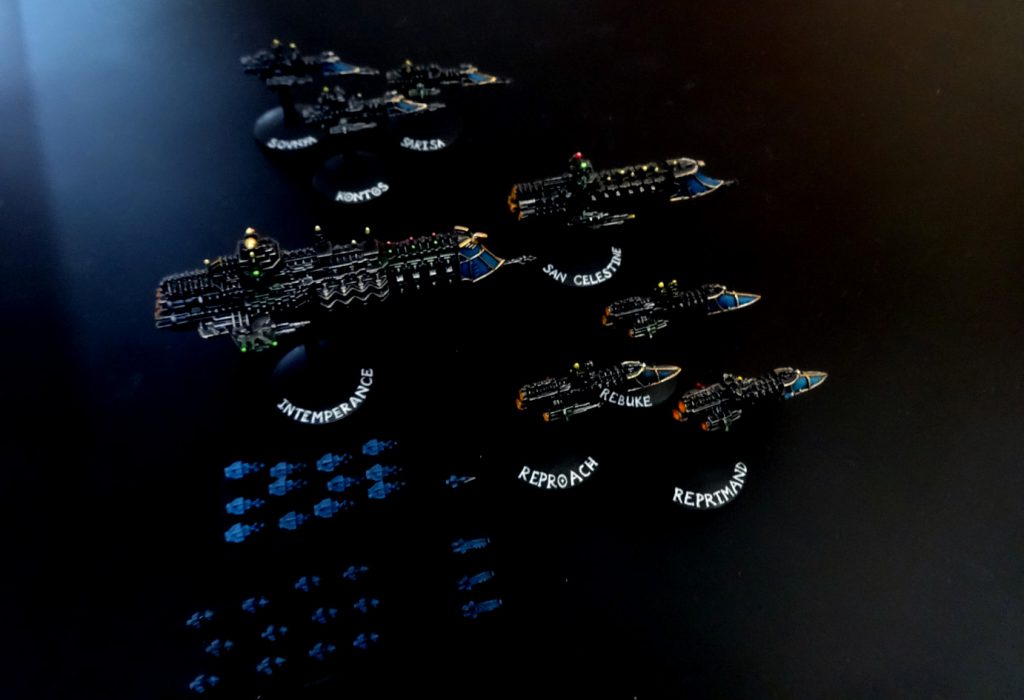
In our campaign, the two players were portraying the captains of the carrier Intemperance and the light cruiser San Celestine. I played it safe for my first attempt and just had the two players, but if I were to run something similar again, I could add two more players to portray the captains of the escort squadrons.
Upon arrival, it transpires that an ork invasion has taken place. There is a substantial fleet in orbit, and the colony won’t last long without assistance. The players can call for reinforcements but those won’t arrive for weeks, so until then the tiny flotilla is instructed to engage in whatever hit and run attacks it can to try and draw the ork ships away from Xephone Prime.
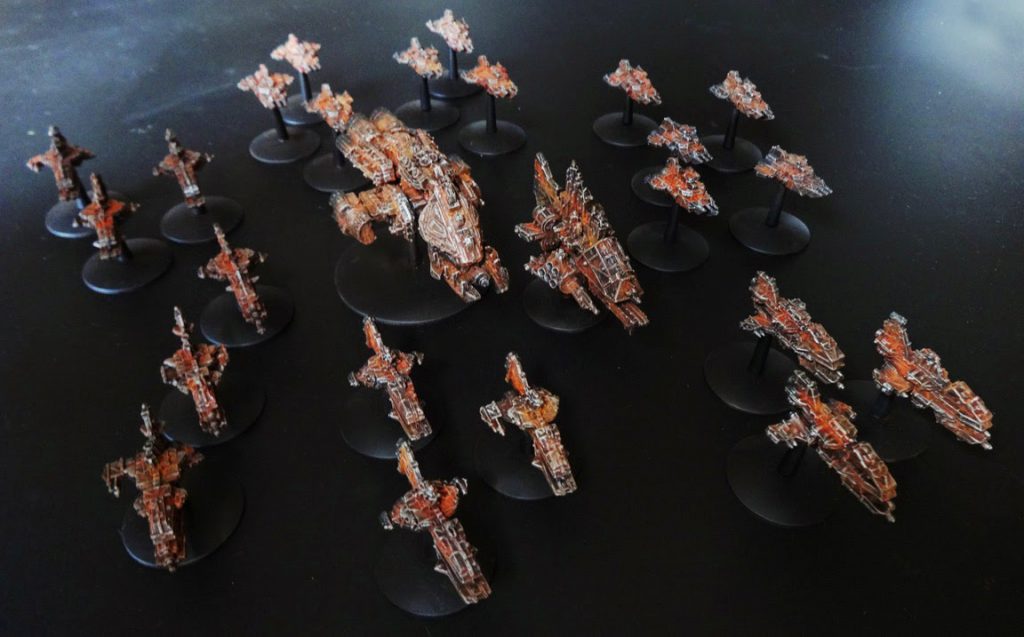
As well as the military conundrum of dealing with a far more numerous (but undisciplined) foe, the players must contend with the internal politicking of their senior officers, some of whom are deliberately trying to undermine the captains (i.e. the players) for their own personal gain. Dealing with those troublesome officers cleverly is the key to preventing mutiny and improving the morale of the crew, since just straight up executing a popular officer could entrench their allies against the player.
What with BFG being the Age of Sail in space, a lot of that politicking happens when the officers sit down for dinner. Barbs and compliments are exchanged all within the strict confines of etiquette; no one says exactly what they think, and everyone’s trying to outmanoeuvre their rivals while subtly helping their allies. It’s all about the players trying to figure out the motivations of their subordinates; after all, the captain of a kilometers-long starship with a crew of thousands has to be a politician as well as a commander.
Roleplaying on an Imperial Navy starship breathed an incredible amount of life and emotional engagement into a game which traditionally feels quite impersonal. A further bonus was that the combination of military and social problems allowed for plenty of tonal variety rather than just one damn fight after another. It also required me to make one or two resources which I shall now share with you. Enjoy.
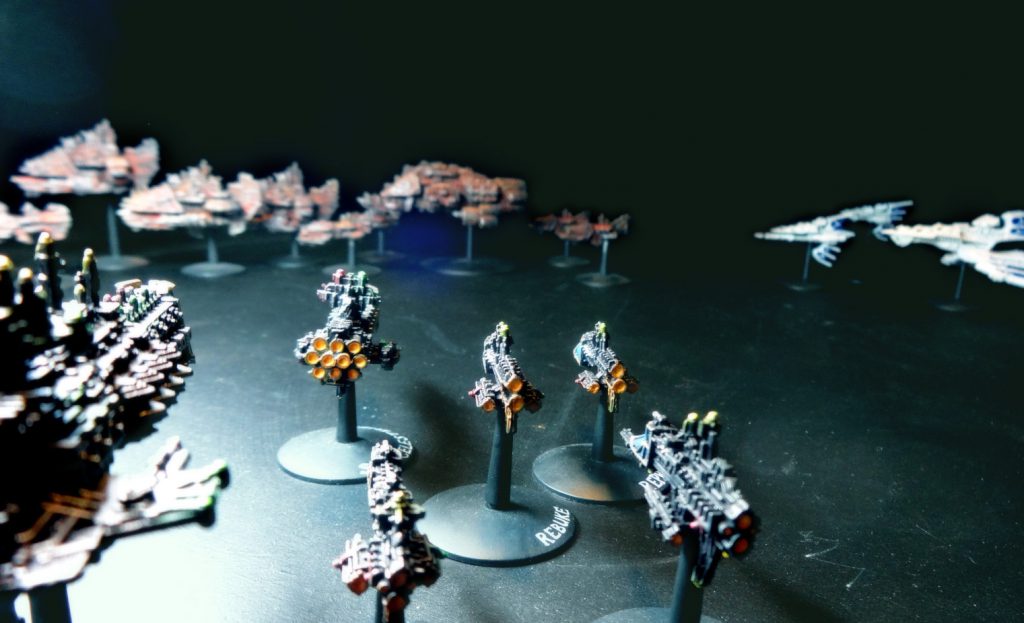
The Invasion of Xephone: Campaign Resources
Xephone System Map – what opportunities does it offer for scenarios?

At first glance, one might assume that scenario possibilities are a bit limited with only one inhabited planet (Xephone Prime) and a mining outpost on an airless moon (Halan’s Prospect). However, the rings of Xephone VI and the asteroid belt both offer plenty of places to have games of cat and mouse. The orks had a mekaniak whose base was somewhere in the asteroid, and trailing enemy supply ships to try and deduce its location made for an enjoyable challenge.
Similarly, any moon or planet offers the opportunity to lure people into an ambush, with ships hiding from scanners on the far side of the planet. With the orks being such primitive space farers there’s also the possibility of running as close to the star as you dare in the hopes that they’ll be unable to follow your movements as their instruments are overloaded by all the star’s emissions.
Inside an Imperial Cruiser
To paint a picture of life on a Navy capital ship, I went full grognard and accounted for all the various areas of the ship, as well as providing names and one-sentence characterisations for the command crew. Obviously these developed as the story went on, but it’s an easy starting point for anyone looking to do something similar.
Note that my estimates of crew size are extremely low relative to some sources like the Rogue Trader RPG. This is because I imagine that while these ships are enormous, a lot of that size would be taken up by the drives, fuel, munitions, and so on. Some areas of the ship would be crowded, yes, but by contrast other areas of the ship were presented as gloomy, empty places only occasionally visited by maintenance personnel. My crew numbers are based on looking at the number of guns and ordnance carried by a ship, and then doubling (or more than doubling) the size of crew needed to man it compared to real WW2 examples of giant turreted guns. I was also running off a comment Andy Chambers (the game’s original author) saying he reckoned maybe 1-2000 crew per damage point, but obviously the official lore has changed since then. If you want more number, then add more number! Number go up! Make moar epic!
Lore and scale inconsistencies notwithstanding, you can check out the fruits of my grognardism here:
- The Intemperance dictator-class cruiser wiki page
- The San Celestine dauntless-class light cruiser wiki page
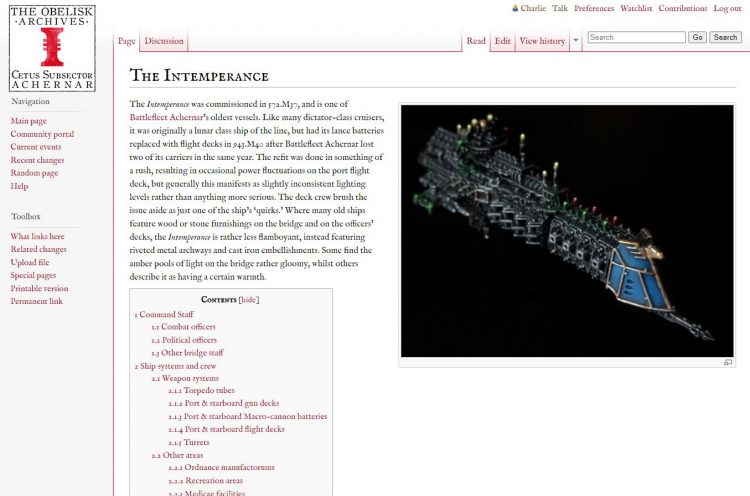
Persistent Damage Rules
Another feature of the campaign was persistent damage and, of course, crew veterancy. The veterancy was easy; we simply used the rules from the BFG core book. Persistent damage, and the repairing of it, is harder to manage with escorts since they only have one damage point, which is a bit all-or-nothing! As such, we used the following rules:
Following an engagement, a capital ship can recover 1 of the hull points it lost during the engagement. Furthermore, any critical hits that could have been repaired by the crew but weren’t are automatically repaired after the engagement, representing the crew doing the easy fixes. To repair other damage, the ship must spend time at a facility capable of repairing starships. As a rough guide, one week (in-fiction, obviously) is sufficient to fix one hull point or critically damaged system. You can, alternatively, choose to perform emergency repairs. This will repair hull points and ship systems at a rate of 1 per day, but until the ship is repaired properly, enemies gain a +1 bonus when rolling to see if the vessel suffers critical damage.
Following an engagement in which an escort was taken out of action, roll a D6:
1: Lost with all hands.
2: Salvageable hulk. The crew were forced to abandon ship, but the survivors can be rescued… or captured, of course. The ship itself could be towed back to the nearest port and repaired, but it will take months.
3: Severe damage. Take a Leadership test for the ship with a -2 Ld modifier. If passed, desperate jury-rigged repairs are sufficient to get it working again. If failed, the margin of failure is the number of weeks needed in port.
4-6: Incapacitated. Take a Leadership test for the ship. If passed, the crew are able to get it working again. If failed, the margin of failure is the number of days needed in port.
Optional Rule: Focussed/split fire
This rule is designed to further help escort ships survive battles in small, skirmish-level campaigns.
When you select a squadron of ships as a target and have determined the number of dice you will roll to make your attacks, you must choose whether to use focussed or split fire.
- Focussed fire means all the hits will be resolved against one of the target vessels.
- Split fire means hits are distributed evenly across all the targets. If you scored 4 hits against 3 escorts, each with a single shield, this would mean you knock out all of their shields, and then the 4th hit destroys the nearest escort.
BFG RP Campaign Concept Two: Charting the Scyrian Expanse
This was the second narrative BFG campaign I ran. Jon, one of the players of the first campaign, was talking about how cool it would be to roleplay some exploration. I suggested the amount of stuff you’d have to generate for the exploration to be meaningful would be preposterous. We joked that clearly some sort of procedural generation would be needed. What sort of obsessive muppet would go and make, like, a hundred star systems and fill some of them with stuff.
Oh, how we laughed.
A few months later I had not only created rules for procedural system generation, but my friend Mike then used those rules to code a deterministic random system generator (see the resources section). This was then used to populate a map of all 105 star systems in a region I named the Scyrian Expanse. The procedurally generated content both inspired details and was also tweaked as needed. With it, I created the 105 star systems of the Scyrian sub-sector. Scattered among the uninhabited systems were whole civilisations, foes, and potential allies. Jon and I suggested our astrophysicist friend Andy should join in and play a rogue trader, meaning Jon, as Laius Ortano, would take charge in fights, while Andy, as Hassiq Betancourt-Xing, would handle any diplomatic situations. We decided to meet up for one evening a week and dove headfirst into the giant celestial sandbox.
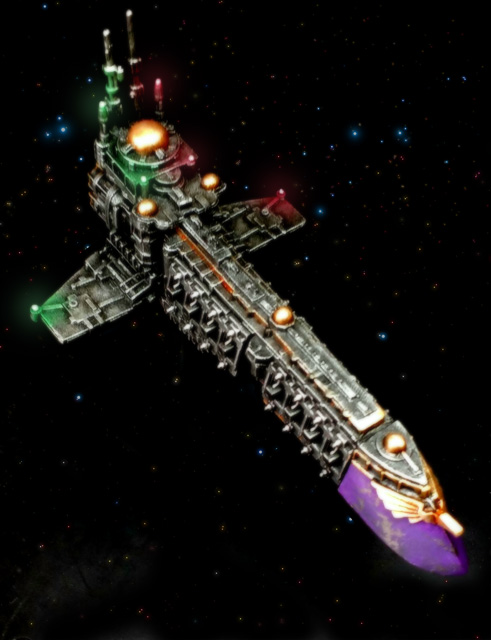
I figured we’d have a few weeks of slow character development as they explored largely empty space. Naturally this was extremely not the case. They randomly decided that their first port of call would be the system designated by the Imperium as SCY-083… which they soon learned was a non-Imperial human system that hadn’t ever heard of the Imperium, and was currently locked in a civil war. The Imperial flotilla could tip the balance one way or the other, so Jon & Andy had to figure out who the factions were and what would best serve the Imperium’s interests. This “sub-plot” was basically a mini campaign within the campaign, occupying the first four evenings we played.
The locals called the system Karana, and so the map was updated accordingly. Having convinced the winning side to join the Imperium, the Navy flotilla sailed on. They founded colonies, encountered strange non-sentient life forms, an artificially intelligent colony ship from the Dark Age of Technology, and the isolated outposts of a slowly waking Necron dynasty. Among other things. Did I mention the campaign was lengthy? It was lengthy. Eventually, they went to check out SCY-039, the system in the middle of the Expanse. The one with five stars.
It was full of orks.
They had at last found out where the invaders of Xephone had come from. It seemed the orks were busily constructing a replacement fleet following their defeat at Xephone, and so the players set about planning a preemptive strike. The only problem was that they were still badly outnumbered, and had to form shaky alliances with humans and xenos they’d met along the way to form a motley armada with which to punish the greenskins, culminating in a preposterously large battle by BFG standards (over 3000 points, played on a 6’x6’ table).
Here’s a step by step image showing how the sub-sector map was updated as they colonised systems and charted stable warp routes:

The Scyrian Expanse: Campaign Resources
Procedural Star System Generator
The link above takes you to a no-frills system generator. The generator takes a “seed” you type into a text box, and the number of stars you want in the system, then procedurally populates those stars with celestial bodies. The output is coded in wiki markup, meaning I could paste it straight into the wiki we use to keep track of our campaign – meaning it’ll look ugly as balls in its raw format. The generator is deterministic, so if you type “Coda is Cool and Good” as the seed, and enter 2 as the number of stars, you will always get the same output. Here’s what the output looks like once it’s in a wiki:
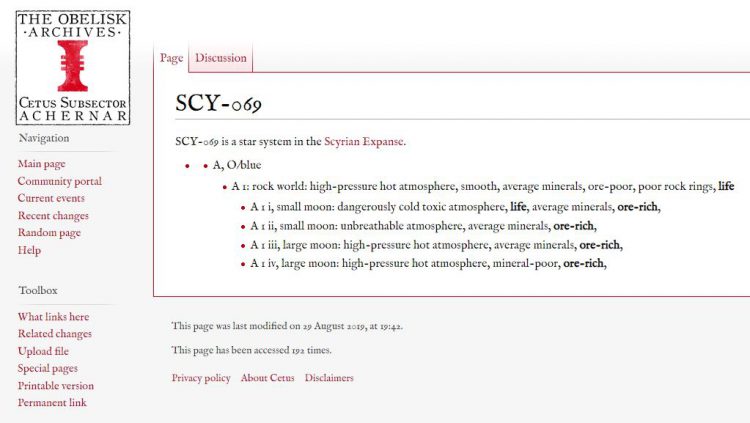
Scyrian Expanse Wiki page
This page of the campaign wiki is where we linked to all the systems the Imperial Expedition charted.
Inside a Rogue Trader Cruiser
Here’s the page detailing the crew and interior of the Zenith. This is very much along the lines of the wiki page for the Intemperance linked above, but for a large civilian vessel.
Integrating BFG with 40K and Other Games
An obvious use of BFG is to use it to launch planetary invasions, evacuations, boarding actions, and so on, then fight those things out on the ground or the air in 40K, Kill Team, Apocalypse, Aeronautica, Adeptus Titanicus, or one of the various flavours of 40K roleplay. This has an obvious appeal and I’ve had a lot of fun doing exactly this. There are also some pitfalls to be avoided. Here, then, are the pitfalls… and some solutions! You’re welcome.
Pitfall #1: Your Fleet Action Prematurely Ends the Story
First and foremost you must ensure that BFG, with its massive guns and equally massive consequences, doesn’t make all the other games redundant. If you’re fighting a planetary invasion but the invasion fleet fails to land any troops, the story is over and no-one got to play 40K! The challenge, therefore, is to have contingencies for how the story will lead to some 40K regardless of the outcome, while still making the BFG fight meaningful, because if it has no consequences, why are you doing it?
Let’s say an Imperial fleet is attempting to land troops on a world that’s been invaded by Chaos. Whatever the result of the BFG game, you want to play some 40K. Obviously if the Imperium succeeds in the assault, you’ve got boots on the ground. Job’s a good’un. But what if the assault fails and the Imperial fleet retreats before it even gets into low orbit? Here are some options.
- Option 1: the Imperial fleet is forced to withdraw after landing no troops, or a small number of troops, but still has some offensive capacity and could mount a second assault. The 40K situation becomes a delaying action where the horrifically outnumbered defenders fight a series of battles to try and draw the conflict out long enough for the fleet to make a second attempt.
- Option 2: the Imperial fleet is damaged beyond all hope of an invasion. The victorious Chaos forces crush all resistance on the planet, and then proceed to the next Imperial world without opposition now that the Imperial fleet is out of play. Rather than the Imperial armies being the attackers in the planetstrike scenario, the Chaos forces become the attackers instead.
Pitfall #2: The Snowball Effect
It’s very tempting to try and represent the consequences of a previous battle with an in-game bonus in the next game. It’s possible to do this well, but often what it does is to create a cascade effect in which the winning side just keeps on winning. Generally, I have found it simpler and more fun to look at how a game went, and then discuss with the other players what the narrative consequences might be, then figure out which scenario in which game system is the most interesting way to move the war forwards. I appreciate that’s an extremely non-competitive approach that won’t suit everyone. I do however urge you to at least consider it, because it gives your campaign a feeling that losing one battle is an interesting development in the story rather than just you losing a game.
Pitfall #3: Why Don’t We Just Blow It Up From Orbit?
It seems reasonable to assume that if you have a spaceship in orbit, and that spaceship has big guns, that you could just pulverise your enemies from space. This does not make for a thrilling game of 40K.
Given that artillery and bombers exist in the 41st millennium, it seems that orbital bombardments aren’t the strategic panacea one might at first assume. Given that Abaddon had to create a special ship (the Planet Killer) specifically to enact exterminatus, we have to assume that regular BFG ships can’t effectively torch whole worlds from space unless they’ve been equipped with virus bombs and the like.
My take on this is that BFG weapons batteries, designed to indiscriminately fill the area around a ship with explosions, are just too imprecise and indiscriminate when fired at a planet, and that furthermore, some if not most of those shells might well detonate prematurely as they’re heated up by atmospheric entry.
Lances, by contrast, are designed to hit a target as big as a kilometers-long spaceship with a beam of light that’s only going to cause a six-foot-wide hole on the battlefield. Such a weapon would need to be fired with impossible precision to meaningfully aim at a target as tiny as a titan relative to the size of the ships it’s designed to hit.
The other main weapon system, of course, is torpedoes. It seems reasonable to assume these could be used to strike ground targets, the problem then being that the ground target, and everything around it, is just gone. You hit it with an ICBM. Woo. There are two main ways to prevent this; one is to ensure that the thing the two sides are fighting over is something they both want, and is worthless if levelled from orbit. The other way is to shoot those torpedoes out of the sky with aircraft and AA turrets/missiles. You could even have a fun scenario in which some suicidal fanatics are attacking the AA defences to allow the torpedo to land.
The exception to the whole ‘nerf all the space guns’ rule is, of course, the Space Marine fleet. 40K’s chonky bois have planetary bombardment cannons explicitly designed for ground attack. So how do you prevent Marines becoming OP in a campaign context?
When I ran a 40K RP campaign for some friends of mine, they each had a strike cruiser. During the campaign turn, they could choose a target for their cruisers’ bombardment cannons. To fire them at anything other than a static landmark, however, they had to get forward observers into position so that they could call in the strike with sufficient accuracy. This meant we could have a scenario in which an army of primarily scouts and other recon troops had to hold off the enemy’s vanguard forces long enough for the comms tank to call in the strike on the enemy’s main force. They get to blow stuff up from space, but it’s more like a limited strategic resource than something you use on the table, and deploying that resource creates a fun scenario.
Of course the other way that resource was limited was that they didn’t always have orbital supremacy. Speaking of which…
Keeping BFG relevant after you’ve landed the troops
Getting boots on the ground is hardly the end of a fleet’s role in a conflict. Whichever side has orbital supremacy will be able to use its carriers to run sorties anywhere on the planet, which provides ample opportunities for Aeronautica Imperialis games as well as games involving aircraft in 40K. This also leads to more BFG games, as one fleet attempts to force the other out of orbit, or at least weaken its presence.
There are other ways in which having orbital supremacy is strategically vital, and that’s logistics. Canonically, escort-sized vessels are capable of landing on world, and this – along with shuttles etc – could be used to ferry supplies into and out of orbit, potentially repairing damaged vessels or resupplying armies on the ground. Logistics, despite being extremely un-sexy, are ultimately one of the best sources of scenario concepts. You might well have scenarios in which a fleet has to hold on to low orbit just long enough for the last few transports to get away, or equally have a scenario on the ground where a rearguard is trying to keep the enemy from reaching the mustering fields long enough to finish an evacuation.
Example tie-in scenario concept: The Battle of Hasmides
Last year I was running a Imperial BFG campaign one night a week, and an Inquisition roleplay campaign on another night. In the climactic battle of the BFG campaign, the player pretty much smashed the enemy fleet but, unfortunately, let his battleship get slightly boarded by Word Bearers. Oops. The Word Bearers weren’t trying to capture the battleship so much as disable it to cover their retreat, and promptly smashed up most of the weapons systems. The situation did, however, suggest a tie-in scenario: one in which the nearby Inquisition vessel would send a team of nutters aboard the stricken battleship to try and capture one of the traitorous Astartes’ officers. Thus, the following week, the Inquisition players rather nervously gathered around the table and fought their way through a series of ship corridors and baroque murder machines, with the BFG player playing as one of the battleship’s terrified technicians tasked with guiding the Inquisition team to their quarry. Good times.
And on that subject… how about some BFG fiction?
For whatever reason, the Battle of Hasmides gave me the idea that it would be fun to write three linked short stories covering the battle. The first story is from the perspective of a junior officer in the Imperial flagship’s strategium. She’d be a background character in a film, but for some reason I liked imagining what a space battle would be like from her perspective. From there it goes on to a short story from an Inquisition storm trooper’s perspective, then to finish off, an Inquisitor has an extremely pleasant conversation with a Word Bearer.
You can find the stories here:
Jon also wrote an in-character captain’s log during his exploration of the Expanse, which you can read here. It covers the aftermath of the first campaign, and the early phases of the second as he journeyed into non-Imperial space. Frankly any moment where you have an excuse to write the words “captain’s log, stardate…” is a giant nerd bonus.

Final Thoughts
Wargames always become more immersive when the battles have consequences beyond the immediate victory. People become more cautious about risking their troops and ships which in turn makes them fight much more like actual leaders rather than the crazed short-term psychos most of us become when fighting a standalone game. If you’ve never played in or run a campaign, start simple, see how you like it, then when it’s over think about what you might add in for the next one. And don’t feel obliged to start some insane years-long epic; you can do a campaign in a weekend. Just play 4 or 5 linked games; keep it self-contained and see how you like it.
Hopefully this article has provided some ideas, or jumping off points, and hopefully it’s revealed the depths of narrative goodness that can be squeezed out of the rich vein that is giant Napoleonic warships in space. This game has been responsible for some of our favourite campaign gaming experiences, and I hope the same is, was, or will be true for you as well!
This final entry brings our Goonhammer review of Battlefleet Gothic, the best game GW ever made, to a close. However, look forward to more Battlefleet Gothic content in the future as we are seeking to run an integrated BFG and Warhammer 40k Crusade campaign to put some of what we’ve discussed into practice in the best way (according to GW) – by forging our own narrative! Thank you everyone for reading, commenting, and pressing your authors when you disagree – we’ve had a lot of fun writing it and hope you’ve enjoyed reading!
